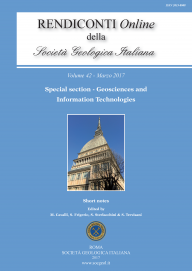
Assessment of sources of PCE contamination in groundwater using a Monte Carlo method in the Functional Urban Area of Milano
Luca Alberti (a), Loris Colombo (a), Giovanni Formentin (b) & Gabriele Oberto (a)
(a) Dipartimento di Ingegneria Civile e Ambientale, Politecnico di Milano, Piazza Leonardo da Vinci, 32, 20133, Milan, Italy.
Corresponding author e-mail: loris.colombo@polimi.it.
(b) Tethys srl, Viale Lombardia 11, Milano, Italy E-mail: giovanni.formentin@tethys.srl.
DOI: https://doi.org/10.3301/ROL.2017.15
Volume: 42/2017
Pages: 62-65
Abstract
Water Framework Directive and Groundwater Directive (2006/118/CE) represent the main European regulations on water resources quality, requiring the identification and management of
contamination sources threatening the achievement of acceptable groundwater quality status. The sources of groundwater contamination can be classified into two different categories: 1) point sources (PS), which are identified areas releasing plumes of high/very high concentrations (i.e. hot-spots) and 2) multiple-point sources (MPS) constituted by a series of unidentifiable small sources clustered in a large area, generating a diffuse contamination. The latter category predominates in European Functional Urban Areas and cannot be managed with the usual remediation techniques such as those conceived for large/medium contaminated sites, mainly because of the difficulty to identify the many different source areas releasing small contaminant mass. Consequently, the usual remediation procedures are not economically sustainable and often fail to provide results in an acceptable time frame. A powerful tool in this context is transport modeling, as it can be used in combination with statistical methods to assess MPS groundwater contamination even in a highly undetermined setting. Due to the uncertainty related to the exact position and intensity of MPS, a numerical model (MODFLOW/MT3DMS) was implemented in a pilot area in the North-Eastern sector of the Milano FUA. Using the inverse calibration code PEST, a model was calibrated representing the diffuse PCE source field (Italian Law limit is within 1.1 mg/l). This was then used as input to a statistical process based on the Null-Space Monte Carlo (NSMC) method, which allows to generate unlimited sets of sources, all respecting the measured concentrations.
99 different realisations were thus obtained, each attributing a contaminant inflow (with varying concentrations) to every cell of the model top layer. The model minimizing the objective function (composed by the diffuse concentration targets in monitoring wells), gives useful information to assess the overall contaminant sources distribution and to identify the probability of each domain sector to contribute to the contaminant mass inflow.
Keywords
Get Full Text